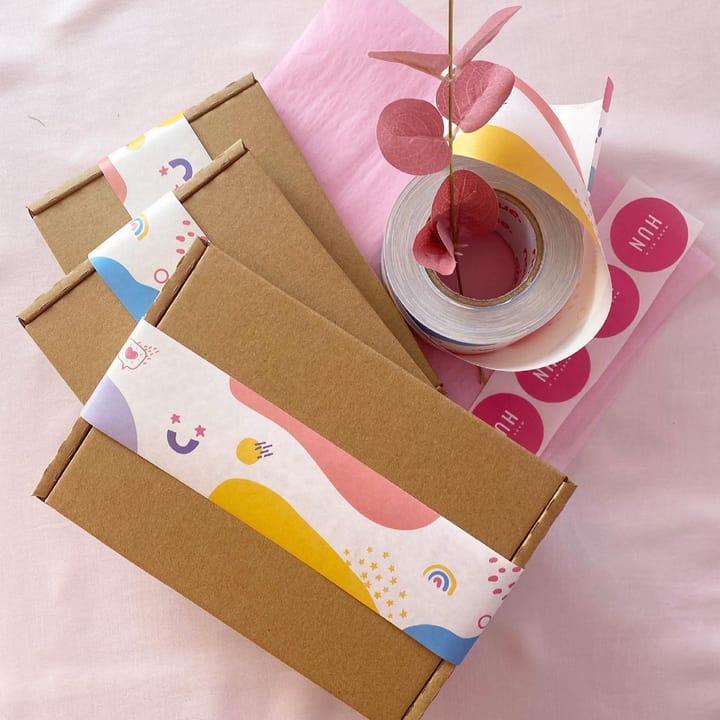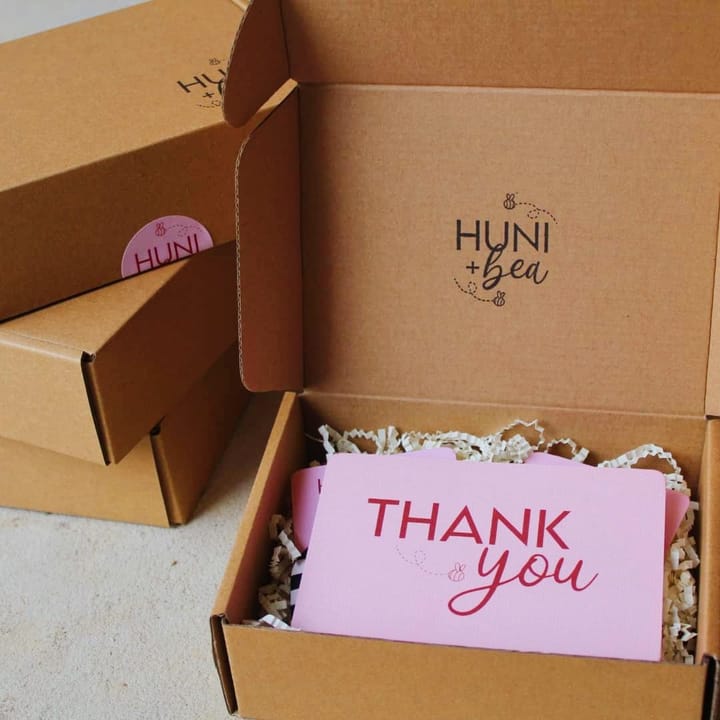
9 Biodegradable Packaging Materials That Can Replace Plastic
Choosing biodegradable packaging for your brand has never been easier. Here's our guide to 9 types of packaging that can replace plastic.
By Francesca Nicasio — 29 October, 2021
Image by @shop_swk
The vast majority of packaging materials have long been made from plastics, and this reliance on synthetic polymers has led to serious ecological problems.
Plastics are major pollutants, and it can take up to 1000 years for plastic to biodegrade. This adverse environmental impact and increasing awareness about the importance of sustainable packaging are pushing brands and customers to adopt biodegradable packaging materials.
Research by McKinsey shows that 55% of consumers are concerned about the environmental impacts of packaging, and 70% of buyers would pay more for sustainable packaging.
Adopting biodegradable and recyclable packaging materials shows your customers that your business is environmentally responsible. In this article, we will explore the ins and outs of biodegradable packaging and how to select the right packaging solutions for your business.
Let's get started!
What is biodegradable packaging?
Biodegradable packaging is made of materials that can decompose easily after disposal under the action of microorganisms. This ability to decompose rapidly helps to control the build-up of waste in landfills and contributes to a safer and healthier environment.
However, being labeled as "biodegradable" does not automatically make a packaging material sustainable. For a biodegradable polymer to qualify as sustainable packaging, it must break down and decompose within a short period — typically 12 months or less.
Does biodegradable mean compostable?
The short answer? No.
Biodegradation lets nature take charge of the process of breaking down packaging materials in landfills into their components. Compostable materials, on the other hand, decompose in composting environments where factors like humidity, temperature, oxygen, and bacteria are carefully controlled.
This means that all compostable packaging materials are biodegradable, but not all biodegradable packaging materials may be compostable.
Why should you consider using sustainable packaging?

Customers are increasingly concerned about sustainability, and research by GreenPrint shows that 75% of millennials are likely to pay a premium for sustainable products. This indicates that customers will be more likely to buy from your business when your packaging and recycling policies reflect their values.
That said, the benefits of biodegradable, sustainable packaging go beyond securing a positive brand image for your company. Below are some of the many benefits of sustainable packaging:
- Zero toxins and allergens. Chemicals like phthalates (common in plastic packaging) can cause health problems like asthma and cancer. Biodegradable packaging is not only good for the environment, it is also completely free of toxic materials.
- Cost savings. Most biodegradable packaging materials are reusable and can be recycled. Investing in sustainable packaging will help you cut costs and free up resources that can be allocated elsewhere.
- Efficient disposal. Sustainable packaging can be labeled as biodegradable, compostable, or recyclable. Customers can easily differentiate between them when discarding these materials, which makes the waste disposal process easier.
Types of biodegradable and eco-friendly packaging materials
Below is a list of the most popular biodegradable packaging materials currently available in the market. You may choose from any of these depending on your product packaging needs:
1. Biodegradable packing peanuts
Packing peanuts (styrofoam) serve as loose-fill packaging for fragile items to provide cushioning against shock and prevent items from moving. However, most packing peanuts are made from polystyrene which is not biodegradable and very difficult to recycle.
Biodegradable packing peanuts serve as an eco-friendly alternative. They work the same way as styrofoam but are made of natural materials like starch and wheat which makes them easily decomposable. Biodegradable packing peanuts are also lighter and less expensive than styrofoam.
2. Corrugated bubble wrap
Just like air peanuts, bubble wrap packaging also protects fragile items during shipping. It is, however, made of plastic which isn't eco-friendly. Fortunately, there are sustainable alternatives.
Made from upcycled corrugated cardboard, corrugated bubble wrap provides the same cushioning effect as traditional bubble wrap. It's environment-friendly since it's made from 100% recycled cardboard paper, which is biodegradable.
3. Recycled cardboard

Cardboard boxes are used to ship a vast majority of products. Their durability, affordability, and reusability make them one of the most preferred materials for packaging products.
However, while cardboard and paper are organic materials, they can have a negative impact on the environment if they are sourced unsustainably. To ensure that your cardboard packaging is eco-friendly, use recycled paper or cardboard only. Alternatively, you can use cardboard materials made with pulp sourced from sustainably managed forests.
noissue's Kraft Boxes are made from 100% Recycled Kraft cardboard Material.
4. Bio-plastics
Plastic packaging is useful for shipping items that require sturdy packaging and can support heavy loads. The good thing is that you can still boost your eco-credentials even when plastic packaging is essential for shipping an item.
Bio-plastics are 100% eco-friendly and biodegradable. They are made from parts of plants like sugarcane, cassava, and corn. Biodegradable plastic is commonly used in food packaging and can replace any type of regular plastic packaging material you currently use.
noissue's Compostable Mailers are made from a combination of PLA (plant materials such as field corn and wheat straw) and PBAT, a bio-based polymer. This means they break down in six months (180 days) at home and 90 days in a commercial compost setting.
5. Inflatable air pillows made from biodegradable materials
Air pillows can be used as a cheaper packaging alternative to styrofoam or bubble wrap. They provide the same cushioning protection for shipped items.
Air pillows are better for the environment because they are simply small bags filled with air. This reduces the amount of plastic required when producing the packaging.
Make sure you only purchase air pillows that are biodegradable and can be reused.
6. Cornstarch packaging
Cornstarch packaging is a sustainable alternative to plastic packaging made from petroleum-based products.
Cornstarch packaging is made with materials derived from the maize plant, and is completely biodegradable. The primary disadvantage of this packaging material is that it competes with humans and animals who use corn as food.
7. Mushroom packaging
Mushroom packaging is made using agricultural waste that is fused together using mushroom roots (mycelium) as the combining material. It is environment-friendly and biodegradable.
Mushroom packaging may be a better packaging option than cornstarch packaging because it only uses agricultural waste which is not food for humans or animals.
8. Organic fabrics
Organic fabrics can serve as an eco-friendly alternative to the ubiquitous plastic bags that have become a staple of product packaging.
Organic fabrics are made from organic materials like hemp, palm leaves, recycled cotton, pineapple leaves, banana, tapioca, and many more. These raw materials are all abundant and packaging made with such materials decomposes rapidly — usually within 100 days.
9. Seaweed packaging
Seaweed packaging is made from a material called agar, which can be found in many types of seaweeds and algae. Agar is a gelatinous substance that is already used in the food industry as a thickening agent.
Research has now extended its use to product packaging. Seaweed packaging is a particularly attractive and eco-friendly packaging option because seaweed is an abundant sustainable raw material.
What to look for when choosing biodegradable packaging

There are several providers out there who can supply sustainable packaging options for your small business. However, you must carefully evaluate them before adopting their solutions. Below are the factors you should consider when choosing a sustainable packaging supplier for your business:
- Branded and beautiful packaging. Branding is important, and eco-friendly does not mean your packaging needs to be bland. Select a supplier that can provide you with branded mailers, tissue paper, cardboards, stickers, and tape.
- Paper over plastic. Paper is always better because it is naturally biodegradable and decomposes faster. Go for FSC (Forest Stewardship Council)-certified paper when making your choice. The certification indicates that the pulp for the paper was sourced in an environment-friendly manner.
- Non-toxic dyes. Packaging is usually dyed using chemicals that can be harmful to the person handling the material and to the environment. Look for packaging that is dyed using natural, non-toxic dyes instead of petroleum-based ink.
If you want to adopt sustainable, biodegradable packaging for your business, look no further than noissue. Our packaging solutions are 100% compostable and biodegradable. You can create your own branded packaging by uploading your logo and design on our website, or an illustration template. We will print and ship your packing materials anywhere in the world within three weeks.
Wrapping it up
With increasing awareness of the environmental impacts of plastic, many cities around the world have started to ban materials derived from fossil fuels. Eco-friendly and sustainable materials are the need of the hour, and biodegradable packaging is exactly what your business needs to stay ahead of the competition.
Follow the tips mentioned above to make the switch today and take your business to greater heights.